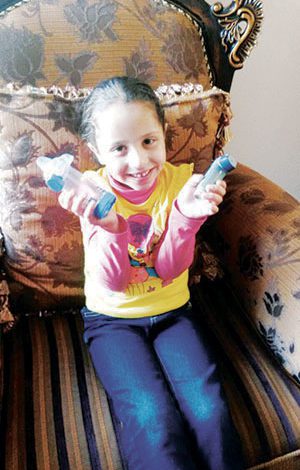
|
| Five-year-old south end resident Marya Aladwar who has asthma. |
DEARBORN — A study was conducted last year by researchers at Wayne State University’s School of Medicine to determine whether there is an association between changes in air pollution and asthma symptoms in young and old Arab Americans.
The Southend of Dearborn is a predominantly low-income, Arab American neighborhood classified by the Environmental Protection Agency as an Environmental Justice Community.
Little is known about environmental asthma triggers in the rapidly-growing population of Arab Americans in the United States.
The study was conducted to see whether the winter season, as opposed to summer, is associated with worse self-rated and objective pulmonary function.
A group of 147 Arab Americans with physician-diagnosed asthma participated in the study and were surveyed. They included 33 boys and 38 girls. The other group included adults, 28 men and 48 women.
The survey covered socioeconomics, self-rated health and pulmonary function, health care utilization and environmental exposures during the summer of 2013 and the winter of 2013-2014. Participants completed respiratory function tests. Air samples were collected and analyzed for particulate matter.
The studied showed every third young and every fifth old participant lived under financial hardship with an average household income of $20,000. A majority of young people were in school, but 45 percent of the elder group lacked formal education, and only 13 percent were employed.
Thirty-two percent of the young and 70 percent of the old participants said their self-reported respiratory health was poor or fair. Both groups reported having worse asthma symptoms in the winter. This concurred with higher levels of air pollutants.
Colds/flu, air pollution and smoke were the most common asthma triggers. During the winter, 34.2 percent of the young and 22.4 percent of the old were hospitalized for asthma, compared to 5.6 percent and 18.3 percent during the summer.
Concerns over environmental pollution increased during the winter. The ratio between observed and predicted forced expiratory volume decreased a statistically significant mean of 4.58 percent in the young and 8.86 percent in the old participants between the summer and winter assessments.
The ratio between forced expiratory flow volume during the first second and forced vital capacity also decreased during the same period (3.96 percent versus 5.43 percent).
In young participants, there was an inverse association between changes in objective lung function and changes in aggregate respiratory symptoms, as well as in self-rated environmental exposures. In old participants, decreased environmental exposures correlated with decreased respiratory symptoms.
Improvement in self-rated air quality correlated significantly with improved lung function.
The study concluded Arab Americans’ pulmonary health is adversely affected by environmental factors. There is also a high degree of concern in the Arab community as to health effects from pollutants.
Dr. Bengt B. Arnetz, a professor of environmental and occupational health at Wayne State’s medical school, is one of the researchers who worked on the study. He said the study concluded that future studies need to delineate pollutant sources in more detail, as well as provide a means to combat adverse health effects.
The study was funded through a grant from the University Research Corridor
of Michigan.
Arnetz noted that Dearborn’s Southend is home to one of the most polluted ZIP codes in the state and country. He pointed out that many of the subjects lacked education and were economically strained.
He also said the study was shared at the 7th International Health Conference on health issues in Arab communities that took place in Muscat, Oman this week.






Leave a Reply